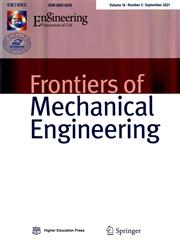Design, characterization and preliminary usability testing of a portable robot for unsupervised therapy of hand function
IF 4
2区 工程技术
Q1 ENGINEERING, MECHANICAL
引用次数: 0
Abstract
Introduction: There is evidence that increasing therapy dose after stroke might promote recovery. Unfortunately, in clinical practice, therapy dose is limited by financial and organizational constraints. Simple robotic devices could be used without supervision in the clinic or at home to increase dose without requiring additional resources. For this purpose, we developed HandyBot, a portable three-degrees-of-freedom end-effector haptic device to perform sensorimotor task-oriented therapy of hand function (i.e., grasping, forearm pronosupination, wrist flexion-extension) in different environments. Methods: We present the mechatronic design of the device and its technical evaluation in terms of workspace, dynamics (i.e., max end-effector velocity, acceleration and force), sensing (i.e., position, velocity and force resolution) and haptic performance (i.e., transparency, maximum stable impedance range, rigid contact rendering accuracy). In addition, its feasibility and usability (in terms of System Usability Scale (SUS)) were assessed in a single-session experiment with four subjects with chronic stroke that tested the HandyBot therapy platform (i.e., haptic device with a graphical/physical user interface and a set of therapy exercises) while simulating unsupervised use (i.e., the subject used the device independently while a therapist was only observing the session). Results: HandyBot showed hardware and control performances comparable to other less portable therapy devices for hand function (e.g., 94% accuracy in stiffness rendering, low apparent mass of 0.2 kg in transparency mode), making it a suitable platform for the implementation of sensorimotor therapy exercises. HandyBot showed good platform usability in terms of SUS (i.e., above 75 out of 100 for device and graphical user interfaces, above 65 out of 100 for the exercises) when tested in simulated unsupervised settings. These tests underlined minor design improvements that should be considered to allow using such a device in uncontrolled settings. Discussion: HandyBot is a novel robot for hand rehabilitation after stroke that revealed high-quality hardware and haptic performance. HandyBot was usable for stroke patients at first exposure for (simulated) unsupervised robot-assisted sensorimotor therapy of hand function. This therapy approach combined with this novel portable robotic device has the potential to help increase therapy dose and decrease therapy-associated costs (e.g., therapist time to therapy time ratio) in different environments.用于手功能无监督治疗的便携式机器人的设计、表征和初步可用性测试
引言:有证据表明,增加中风后的治疗剂量可能会促进康复。不幸的是,在临床实践中,治疗剂量受到财务和组织限制。简单的机器人设备可以在没有监督的情况下在诊所或家中使用,以在不需要额外资源的情况下增加剂量。为此,我们开发了HandyBot,这是一种便携式三自由度末端执行器触觉设备,用于在不同环境中对手部功能(即抓握、前臂旋前旋、手腕屈伸)进行以感觉运动任务为导向的治疗。方法:我们介绍了该设备的机电一体化设计及其在工作空间、动力学(即最大末端执行器速度、加速度和力)、传感(即位置、速度和力分辨率)和触觉性能(即透明度、最大稳定阻抗范围、刚性接触渲染精度)方面的技术评估。此外它的可行性和可用性(根据系统可用性量表(SUS))是在一项针对四名慢性中风受试者的单次实验中评估的,该实验测试了HandyBot治疗平台(即具有图形/物理用户界面和一组治疗练习的触觉设备),同时模拟了无监督的使用(即,受试者在治疗师仅观察疗程时独立使用该设备)。结果:HandyBot在硬件和控制性能方面与其他不太便携的手部功能治疗设备相当(例如,硬度渲染的准确率为94%,透明模式下的低表观质量为0.2公斤),使其成为实施感觉运动治疗练习的合适平台。当在模拟无监督设置中进行测试时,HandyBot在SUS方面表现出良好的平台可用性(即,设备和图形用户界面的可用性高于75%(满分100),练习的可用性超过65%(满分100。这些测试强调了应考虑的微小设计改进,以允许在不受控制的环境中使用此类设备。讨论:HandyBot是一款用于中风后手部康复的新型机器人,具有高质量的硬件和触觉性能。HandyBot可用于中风患者首次接触(模拟)无监督机器人辅助的手部功能感觉运动治疗。这种治疗方法与这种新型便携式机器人设备相结合,有可能在不同环境中帮助增加治疗剂量并降低治疗相关成本(例如,治疗师时间与治疗时间的比率)。
本文章由计算机程序翻译,如有差异,请以英文原文为准。
求助全文
约1分钟内获得全文
求助全文
来源期刊

Frontiers of Mechanical Engineering
Engineering-Mechanical Engineering
CiteScore
7.20
自引率
6.70%
发文量
731
期刊介绍:
Frontiers of Mechanical Engineering is an international peer-reviewed academic journal sponsored by the Ministry of Education of China. The journal seeks to provide a forum for a broad blend of high-quality academic papers in order to promote rapid communication and exchange between researchers, scientists, and engineers in the field of mechanical engineering. The journal publishes original research articles, review articles and feature articles.
 求助内容:
求助内容: 应助结果提醒方式:
应助结果提醒方式:


